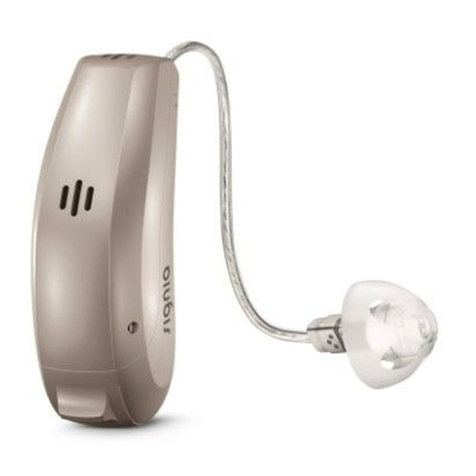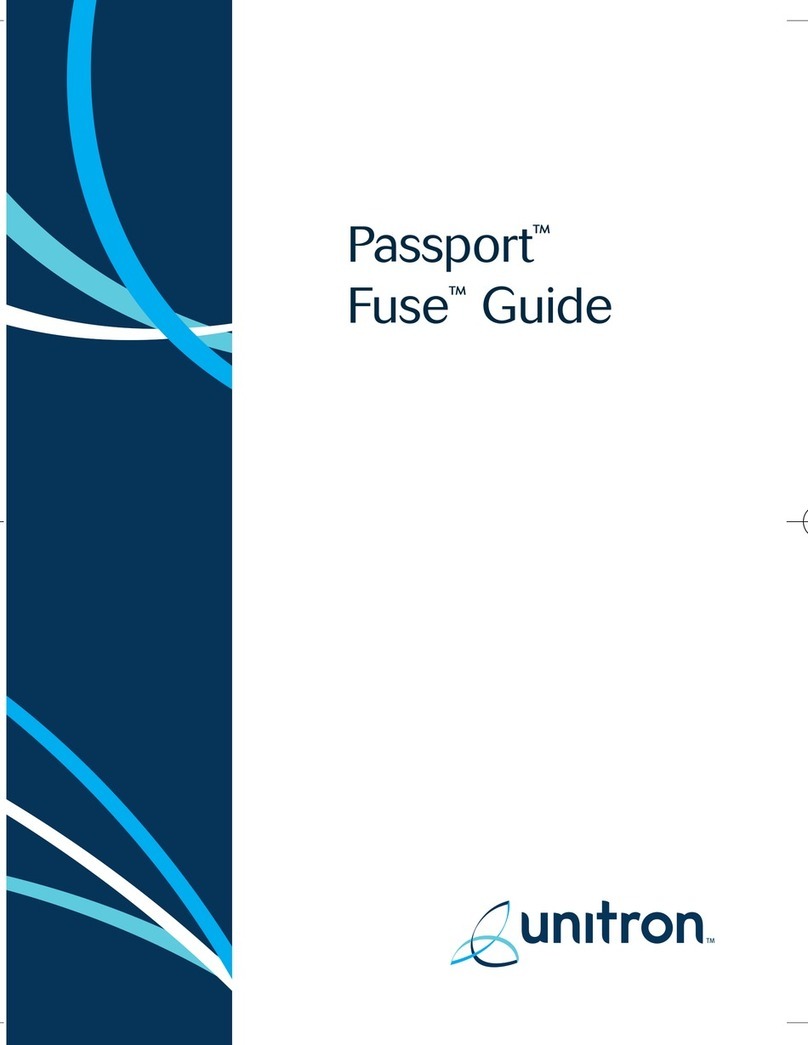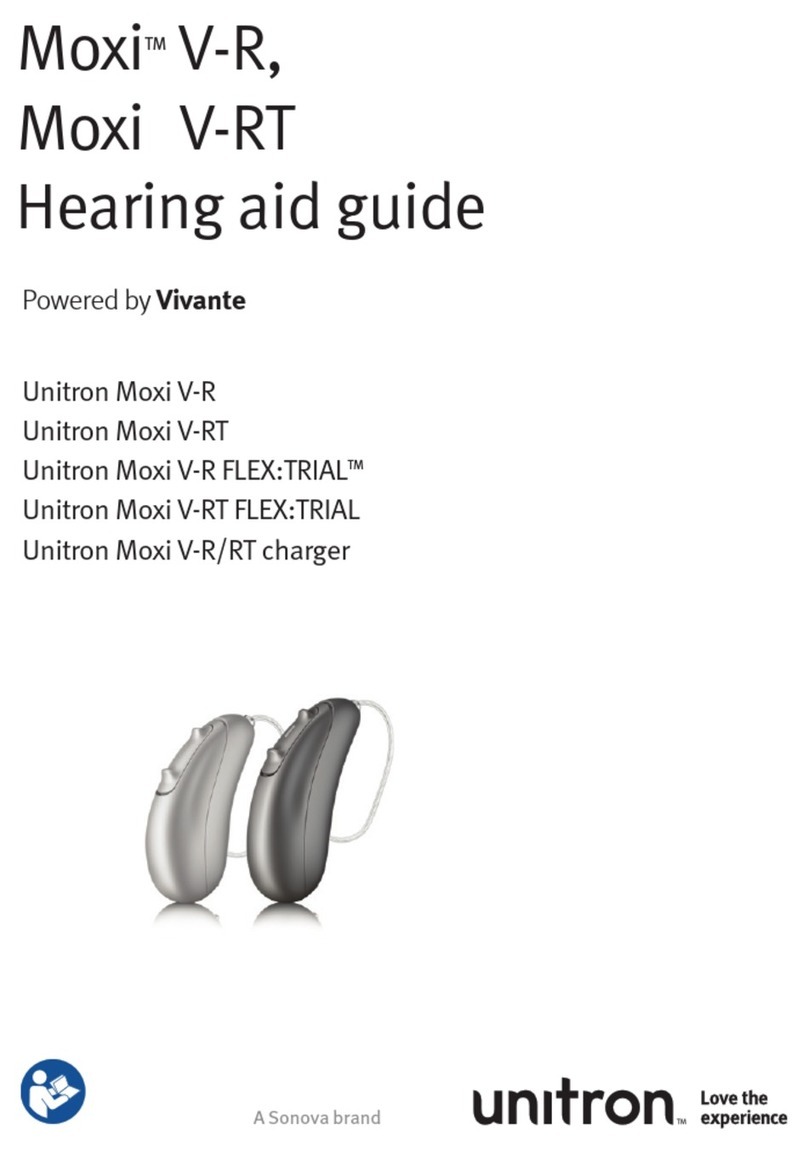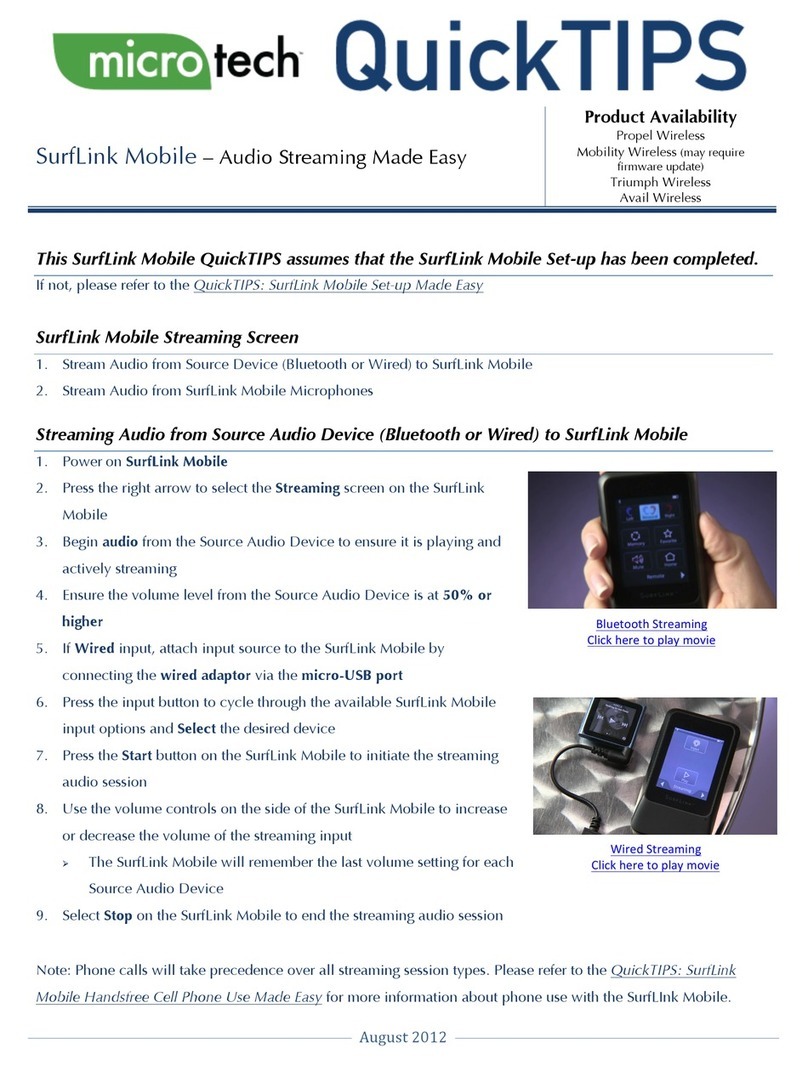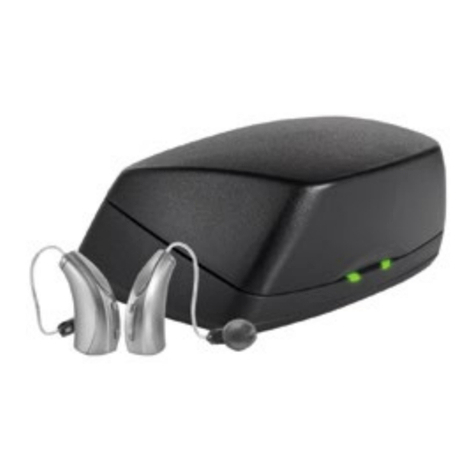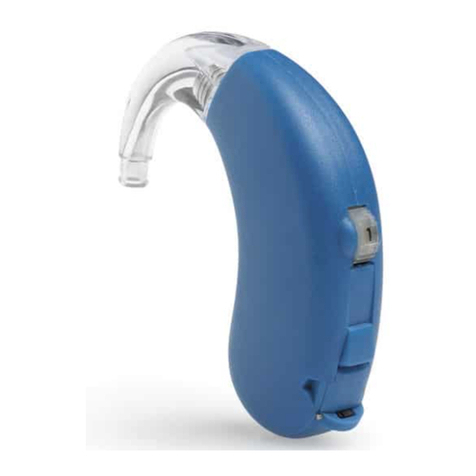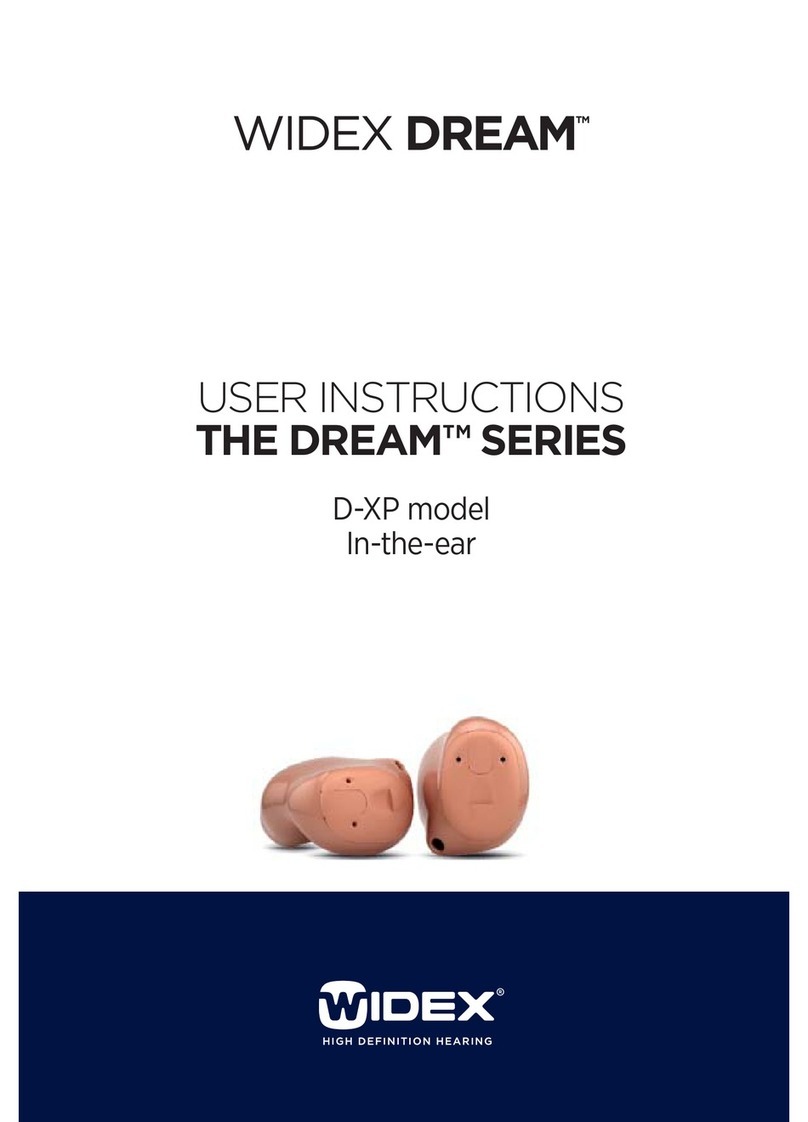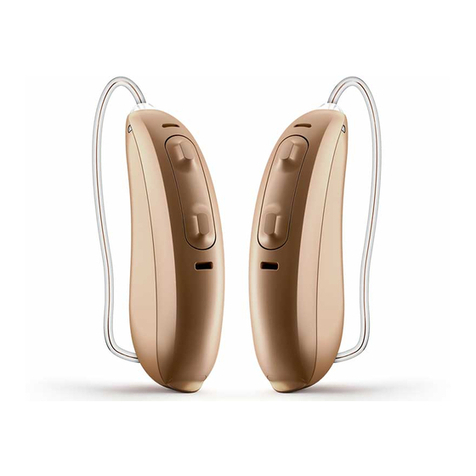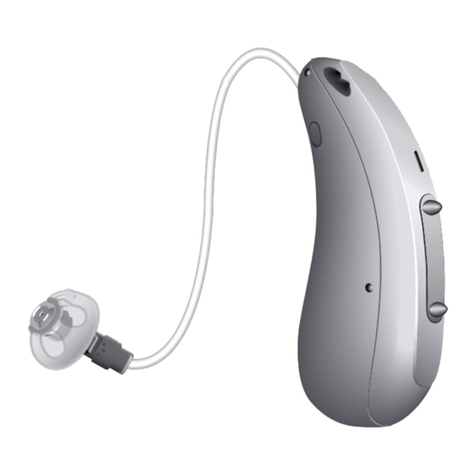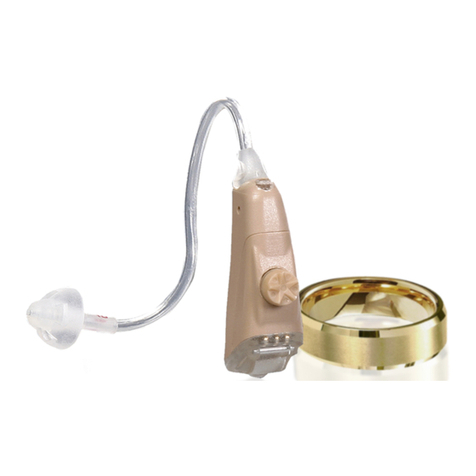Egger ePRO-ER User manual

User instructions for hearing protection egger ePRO-ER
With your new, custom-made hearing protection egger ePRO-ER you have decided to protect your
hearing against damaging or disturbing noise by using custom-made protectors. Your hearing
protection device has been manufactured to fit your ear perfectly and is guaranteed to offer you
the highest possible wearing comfort. We hope you enjoy it thoroughly!
Prior to using your hearing protection device
Please read these instructions carefully to familiarize yourself with the proper handling of the
hearing protection device. Only if the following suggestions are adhered to can effective pro-
tection and the durability of your hearing protectors be guaranteed. Keep these instructions in a
safe place.
Standard features of your hearing protection device
• Hearing protection earmold (Note color marks: right ear/red, left ear/blue)
•Attenuation element for the hearing protectors (1 pair)
•Wax pin (Use the metal loop to remove cerumen deposits from the hearing protectors.)
•Case
•User instructions
Additional features of your hearing protection device
•Cedis care gel to ease inserting the protectors
•Antimicrobial coating
Optional additional features and products
•Attenuation elements with different attenuation effect (see table “Technical data”)
•egger care products for cleaning and disinfecting (e.g. Cedis cleansing spray)
•Headset for telephone and radio communication (for many common models)
•Earphone, e.g. for MP3 player or similar devices
•Metal detection ball
Your hearing protection device is equipped with a sound canal, which contains an attenuation
element. Depending on your requirements, you may use other attenuation elements, which can be
purchased from your specialist. Moreover, it is possible to use further additional products from
egger, e.g. a headset for telephone and radio communication or an earphone for MP3 players.
Warning: As a hearing protection device the egger ePRO-ER may only be used in connection with
additional products (e.g. attenuation elements, headset etc.) that have been type-tested with egger
ePRO-ER. More information is available from your specialist or the manufacturer.
Inserting and removing your hearing protection device (see figure 2 to 4)
1. With clean hands, take the hearing protection egger ePRO-ER out of the packaging.
2. Make sure that your entire hearing protectors (including attenuation element) have not been
damaged and are clean. Do not insert damaged hearing protection devices into ear; in case
of damage, please contact your specialist.
3. Note the red and blue color marks on your hearing protectors:
red = protector for the right ear; blue = protector for the left ear.
4. Take the right protector into your right hand, the left protector into your left hand. Be sure to
grasp the protector from the bottom with your thumb and from the top with your index finger
(figure 2).
5. Take the hearing protector to your ear without twisting it. Angling it from behind, insert it into
the auditory canal (figure 3). Be sure to insert the hearing protection devices deeply enough
and position it comfortably (figure 4).
6. To facilitate the insertion of the protectors, we recommend using Cedis care gel (see additional
products).
7. To remove the hearing protector grasp the earmold with your thumb and index finger and pull
the protector out of your ear. Alternatively you can free the hearing protector by lifting it slightly
with your thumb and then removing it from your ear with your thumb and index finger (see
figure 2).
ATTENTION
• Even a brief exposure to a high noise level while wearing improperly inserted hearing
protectors or no hearing protection devices at all may damage your hearing.
• Only expose yourself to high noise levels while wearing your custom-made hearing protec-
tors after you are familiar with handling the protectors and inserting them properly into the
auditory canal.
It may be helpful for beginners to practise the correct technique in front of a mirror.
• If the attenuation element is missing, do not wear the hearing protection devices in extreme
noise levels!
• Alternations to the shape of the ear may lead to the deterioration of the earmolds’ secure
t, e. g. weight changes. We recommend having the secure seal of your hearing protectors
checked after 2 years at the latest.
• Please consider: While wearing the hearing protection devices, the signals in the surround-
ing area will also be mufed (e. g. warning signals). In addition, be sure to adhere to the
regulations regarding the use of hearing protection devices in road traffic/track superstruc-
ture.
Storage and care
This product may suffer if certain chemical substances are used. Your hearing protectors must
be cleaned regularly to avoid a decrease in its protective effectiveness, or the development of skin
irritations or other ear problems. Use either special cleaning products offered by the manufacturer
or at least water and soap. Dry the hearing protectors thoroughly before inserting them again.
Do not use chemical solvents, abrasive cleansers or brushes. The attenuation elements must be
cleaned professionally. More information is available from your hearing protection professional or
the manufacturer. Store the egger ePRO-ER in the case which is included in delivery.
WARNING
•Sudden or fast removal of the ear plugs out of the ear canal may damage the ear drum.
•If the suggestions in these instructions are not adhered to, the effectiveness of the hearing pro-
tection device may be affected considerably. Only by handling the hearing protectors carefully
and wearing the hearing protection egger ePRO-ER continuously in extreme noise levels, are
you protecting your hearing as best as possible. Therefore, we urgently recommend using and
maintaining the hearing protection egger ePRO-ER according to these suggestions.
PLEASE NOTE
egger ePRO-ER hearing protection devices are manufactured individually after ear impression
taking. They conform to the regulations of Directive 89/686/EEC (Personal Protective Equipment)
and EN 352-2. Tested by PZT GmbH, An der Junkerei 48 F, D-26389 Wilhelmshaven. European
notified body with the identification number 1974.
1
4
DGBDGB FIE
Technische Daten des Gehörschutzes egger ePRO-ER nach EN 352-2:2002
Technical data of the hearing protection egger ePRO-ER in accordance with EN 352-2:2002
Données techniques de la protection auditive egger ePRO-ER selon la norme EN 352-2:2002
Dati tecnici dell’otoprotettore egger ePRO-ER conforme a EN 352-2:2002
Datos técnicos de la protección auditiva egger ePRO-ER conforme a EN 352-2:2002
Mf: Mittelwert der Schalldämmung in dB
Sf: Standardabweichung in dB
APV: Angenommene Schutzwirkung in dB
SNR: Single Number Rating
L: Dämmwerte für tieffrequente Geräusche
M: Dämmwerte für mittelfrequente Geräusche
H: Dämmwerte für hochfrequente Geräusche
S: Signalhören im Gleisoberbau möglich
V: Signalhören im Straßenverkehr möglich
W: Kriterien „Warnsignalhören allgemein“, „informationshaltige Geräusche“ und „Sprachverständlichkeit“ erfüllt
E: Signalhören für Triebfahrzeugführer und Lokrangierführer im Eisenbahnbetrieb möglich
Mf: Mean attenuation in dB
Sf: Standard deviation in dB
APV: Assumed protection in dB
SNR: Single Number Rating
L: Attenuation values for low frequency noises
M: Attenuation values for medium frequency noises
H: Attenuation values for high frequency noises
S: Hearing of signals in track superstructure possible
V: Hearing of signals in road traffic possible
W: Criteria “Hearing of warning signals in general”, “Informative noises” and “Speech comprehension” fulfilled
E: Hearing of signals is an option for railway traction vehicle and train shunting staff
Mf: Atténuation moyenne en dB
Sf: Ecart type en dB
APV: Protection effective en dB
SNR: Single Number Rating (Valeur d’atténuation globale)
L: Valeur d’atténuation pour les hautes fréquences
M: Valeur d’atténuation pour les fréquences moyennes
H: Valeur d’atténuation pour les basses fréquences
S: Perception des signaux en l’infrastructure de la voie est possible
V: Perception des signaux dans la circulation routière est possible
W: Critères « signaux sonores en général » , « bruits informatifs » et « compréhension linguistique » réalisés
E : Perception des signaux pour conducteurs de train et conducteurs de locomotive dans l’exploitation ferroviaire
Mf: Valore medio dell’insonorizzazione espresso in dB
Sf: Deviazione standard espressa in dB
APV: Efficacia protettiva supposta, espressa in dB
SNR: Single Number Rating
L: Valori di insonorizzazione per rumori a bassa frequenza
M: Valori di insonorizzazione per rumori a media frequenza
H: Valori di insonorizzazione per rumori ad alta frequenza
S: Possibilità di percepire i segnali anche per gli operai impiegati in lavori ai binari ferroviari
V: Possibilità di percepire i segnali anche per gli operai impiegati nella circolazione stradale
W: I criteri “Segnali d’allarme in generale”, “Rumori che trasmettono informazioni” e
“Comprensibilità” sono adempiti
E: Possibilità di percepire i segnali per conducenti di automotrici e manovratori di locomotive nel traffico
ferroviario
Mf: Atenuación media en dB
Sf: Desviación estándar en dB
APV: Protección calculada en dB
SNR: Single Number Rating
L: Valores de atenuación para ruidos de frecuencia baja
M: Valores de atenuación para ruidos de frecuencia media
H: Valores de atenuación para ruidos de frecuencia alta
S: Posibilidad de oír enseñales en superestructura de la vía
V: Posibilidad de oír enseñales en el tráfico
W: Criterios cumplidos de “Oír señales de aviso en general”, “Ruidos informativos” y
“Comprensibilidad de lengua”
E: Posibilidad de oír señales para los maquinistas y los encargados de maniobras en las explotaciones
ferroviarias
rechts · right · droite · destro · derecholinks · left · gauche · sinistro · izquierdo
Hz 63 125 250 500 1000 2000 4000 8000
ER stop Mf 26,6 27,9 29,1 30,6 32,7 37,4 31,1 37,1
Sf 3,7 4,1 4,8 5,4 4,4 5,5 4,7 5,2
APV 22,9 23,8 24,3 25,2 28,3 31,9 26,4 31,9
SNR: 30 – H: 29, M: 28, L: 26 – S, V, W, E
ER 25 Mf 23,4 24,6 23,7 24,2 26,9 27 29,5 30,9
Sf 4,8 5,5 4,4 4,3 3,6 3 3,8 3,8
APV 18,6 19,1 19,3 19,9 23,3 24 25,7 27,1
SNR: 25 – H: 25, M: 23, L: 21 – S, V, W, E
ER 15 Mf 19,9 19,9 19,6 17,6 17,5 14,4 15,4 22,8
Sf 5,1 3,7 4,9 3 2,9 2,3 3,1 4,3
APV 14,8 16,2 14,7 14,6 14,6 12,1 12,3 18,5
SNR: 15 – H: 13, M: 14, L: 14 – S, V, W, E
ER 9* Mf 16 15,9 12,9 11 11,2 12,3 12,6 22,3
Sf 5,1 3,5 3,3 2,6 2,6 2,9 2,4 3,9
APV 10,9 12,1 9,6 8,4 8,6 9,4 10,2 18,4
SNR: 11 – L: 9, M: 9, H: 10
*ER 9:
Mit dem Dämmelement „ER 9“ ist der „egger ePRO-ER“ keine Persönliche Schutzausrüstung
(Gehörschutz), da er die Anforderung an die Mindestschalldämmung aus der EN 352-2 nicht
erfüllt. Er darf deswegen nur zu Komfortzwecken eingesetzt werden, z. B. bei störenden
Hintergrundgeräuschen.
With the attenuation element “ER 9” the “egger ePRO-ER” does not qualify as personal pro-
tective equipment (hearing protection devices), as it does not fulfill the requirement for
minimum attenuation in accordance with EN 352-2. It may only be used for leisure purposes,
e.g. to attenuate disturbing background noises.
Avec l’élément d’atténuation « ER 9 » le « egger ePRO-ER » n’est pas un équipement de
protection individuelle (protection anti-bruit), parce que l’exigence à l’atténuation minimale
en accordance avec EN 352-2 n’est pas remplie. De ce fait ne que l’employer à un moyen
de confort, par. ex. contre des interférences.
Con l’elemento isolante “ER 9” l’“egger ePRO-ER” non è un dispositivo di protezione in-
dividuale (otoprotettore), dato che non è conforme ai requisiti di insonorizzazione minima
della EN 352-2. Per questo motivo deve essere utilizzato esclusivamente a scopo di como-
dità, ad es. in caso di rumori di sottofondo fastidiosi.
Con el elemento de atenuación “ER 9”, “egger ePRO-ER” no es comprendido como equipo
de protección individual (protección auditiva), porque no cumple el requisito a la atenuación
mínima conforme a EN 352-2. Sólo se debe usar para sentir más cómodo, p.ej. en ambientes
con ruidos al fondo molestados.
Gebrauchsanleitung für egger ePRO-ER Gehörschutz
Mit Ihrem neuen, speziell für Sie angefertigten Gehörschutz egger ePRO-ER haben Sie sich für
den individuellen Schutz Ihres Gehörs vor schädigendem oder störendem Lärm entschieden. Ihr
Gehörschutz kommt einem Maßanzug für Ihr Ohr gleich und gewährleistet Ihnen stets höchst-
möglichen Tragekomfort. Wir wünschen Ihnen viel Freude damit!
Bevor Sie den Gehörschutz in Gebrauch nehmen
Bitte lesen Sie diese Gebrauchsanleitung sorgfältig durch und machen Sie sich mit der richtigen
Handhabung vertraut. Die Schutzwirkung und Haltbarkeit Ihres Gehörschutzes ist nur bei Beach-
tung der nachfolgenden Hinweise gegeben. Bewahren Sie die Gebrauchsanleitung auf.
Gehörschutz-Grundausstattung
• Gehörschutz-Passstück (Farbmarkierung beachten: rechtes Ohr rot/linkes Ohr blau)
•Gehörschutz-Dämmelement (1 Paar)
•Cerumen-Pin (Metallschlinge zur Entfernung von Ablagerungen am Gehörschutz)
•Etui/Täschchen
•Gebrauchsanleitung
Gehörschutz-Zusatzausstattung
•Cedis Pflegegel zum leichteren Einsetzen
•Antimikrobielle Beschichtung
Optionale Zusatzausstattung und -produkte
•Dämmelemente mit unterschiedlicher Dämmwirkung (s. Tabelle „Technische Daten“)
•egger Pflegeprodukte für Reinigung und Desinfektion (z.B. Cedis Reinigungsspray)
•Headset für Telefon und Funk (für viele gängige Modelle)
•Im-Ohr-Kopfhörer, z.B. für MP3-Player o.ä.
•Detektionskugel
Ihr Gehörschutz verfügt über einen Schallkanal in dem das Dämmelement platziert ist. Je nach
Bedarf stehen zusätzliche Dämmelemente zur Verfügung, die Sie von Ihrem Fachberater beziehen
können. Weiterhin ist die Verwendung weiterer Zusatzprodukte von egger ermöglicht; z.B. Head-
set für Telefon und Funk oder Im-Ohr-Kopfhörer für MP3-Player. Warnung: Als Gehörschutz darf
nur der egger ePRO-ER in Verbindung mit Zusatzprodukten (z.B. Dämmelementen, Headset
etc.) verwendet werden, die zusammen mit dem egger ePRO-ER baumustergeprüft sind. Weitere
Informationen dazu erhalten Sie von Ihrem Fachberater oder können beim Hersteller angefordert
werden.
Einsetzen und Entnehmen des Gehörschutzes (s. Skizze 2 bis 4)
1. Nehmen Sie den Gehörschutz egger ePRO-ER mit sauberen Händen aus der Verpackung.
2. Vergewissern Sie sich, dass Ihr Gehörschutz komplett, inklusive Dämmelement, unbeschädigt
und sauber ist. Beschädigter Gehörschutz darf nicht ins Ohr eingesetzt werden. Bitte setzen
Sie sich ggf. mit Ihrem Fachberater in Verbindung.
3. Achten Sie auf die Farbmarkierung rot bzw. blau an Ihrem Gehörschutz:
rot = Gehörschutz für das rechte Ohr; blau = Gehörschutz für das linke Ohr.
4. Nehmen Sie den rechten Gehörschutz in die rechte Hand, den linken in die linke Hand, wobei
der Daumen unten am Passstück und der Zeigefinger oben am Griffstück zufassen (Skizze 2).
5. Führen Sie den Gehörschutz ohne Drehbewegung zum Ohr und setzen Sie ihn von hinten in
den Gehörgang ein (Skizze 3). Stellen Sie sicher, dass er tief genug und bequem im Ohr sitzt
(Skizze 4).
6. Das Einsetzen kann durch Verwendung von Cedis Pflegegel (s. Zusatzprodukte) erleichtert
werden.
7. Zum Entnehmen greifen Sie mit Daumen und Zeigefinger das Passstück und ziehen Sie den
Gehörschutz aus dem Ohr. Alternativ können Sie den Gehörschutz durch leichtes Anheben mit
dem Daumen von unten lockern und anschließend mit Daumen und Zeigefinger (s. Skizze 2)
aus dem Ohr entnehmen.
ACHTUNG
•Selbst der kurzzeitige Aufenthalt im Lärmbereich mit falsch eingesetztem oder ohne
Gehörschutz kann Hörschäden verursachen.
• Betreten Sie den Lärmbereich erst dann mit Ihrem maßgefertigten Gehörschutz, wenn Sie
mit der Handhabung vertraut sind und der richtige Sitz im Gehörgang sichergestellt ist.
Zu Beginn kann die Handhabung vor einem Spiegel leichter eingeübt werden.
• Bei fehlendem Dämmelement darf der Gehörschutz im Lärmbereich nicht getragen
werden!
• Anatomische Veränderungen der Ohrform können dazu führen, dass die Dichtigkeit der
Ohrpassstücke nachlässt, z. B. bei Gewichtsveränderung. Wir empfehlen eine Überprüfung
Ihrer Gehörschutz-Passstücke nach spätestens 2 Jahren.
• Bitte berücksichtigen Sie, dass Sie bei eingesetztem Gehörschutz auch Signale in Ihrer
Umgebung (z. B. Warnsignale) leiser hören. Zusätzlich müssen die Bestimmungen zur
Verwendung von Gehörschutz im Straßenverkehr/Gleisoberbau beachtet werden.
Aufbewahrung und Pege
Dieses Produkt kann durch bestimmte chemische Substanzen leiden. Ihr Gehörschutz muss re-
gelmäßig gereinigt werden um ein Nachlassen der Schutzwirkung, Hautreizungen oder andere
Ohrprobleme zu vermeiden. Verwenden Sie entweder spezielle Reinigungsprodukte des Herstellers
oder mindestens Wasser und Seife. Trocknen Sie den Gehörschutz vor dem erneuten Einsetzen
vollständig ab. Verwenden Sie keine chemischen Lösungsmittel, Scheuermittel oder Bürsten.
Die Dämmelemente müssen fachmännisch gereinigt werden. Weitere Informationen erhalten Sie
vom Ihrem Ansprechpartner für Gehörschutz oder können beim Hersteller angefordert werden.
Bewahren Sie den egger ePRO-ER im mitgelieferten Etui/Täschchen auf.
WARNUNG
•Plötzliches oder schnelles Entfernen des Gehörschutzstöpsels aus dem Gehörgang kann das
Trommelfell beschädigen.
•Sollten die Hinweise aus dieser Anleitung nicht eingehalten werden, kann die Schutzwirkung
erheblich beeinträchtigt werden. Nur durch sorgfältige Handhabung und ständiges Tragen des
egger ePRO-ER Gehörschutzes im Lärm, sichern Sie sich den bestmöglichen Schutz Ihres
Gehörs. Wir empfehlen Ihnen daher dringend, den egger ePRO-ER Gehörschutz entsprechend
diesen Hinweisen zu verwenden und zu pflegen.
HINWEIS
egger ePRO-ER Gehörschutz ist ein individuell nach Ohrabformung gefertigter Gehörschutz.
Er entspricht den Bestimmungen der Richtlinie 89/686/EWG (Persönliche Schutzausrüstungen)
und EN 352-2. Geprüft durch die PZT GmbH, An der Junkerei 48 F, D-26389 Wilhelmshaven.
Europäisch notifizierte Stelle, Kenn-Nummer 1974.
79614101-2013-11
2 3
Maßgefertigter Gehörschutz
Custom-made hearing protectors
Protection acoustique sur mesure
Otoprotettore su misura
Protección auditiva a medida
ePRO-ER
Gebrauchsanleitung
User instructions
Mode d’emploi
Istruzioni per l’uso
Instrucciones de uso

Mode d’emploi pour egger ePRO-ER protection acoustique
Avec votre protecteur anti-bruit egger ePRO-ER (fabriqué sur mesure) vous avez choisi une
protection individuelle de votre ouïe contre bruit nuisant ou gênant. Votre protecteur anti-bruit
ressemble à un complet sur mesure pour votre oreille qui vous assure toujours un haut confort
de port. Nous vous souhaitons beaucoup de plaisir avec ce produit !
Avant d’utiliser votre protecteur acoustique
Lisez soigneusement le mode d’emploi et accommodez-vous au propre maniement.
Afin d’assurer l’effet protecteur et sa durée de vie, votre protecteur acoustique demande une
attention toute particulière. Gardez bien ce mode d’emploi.
Protection acoustique – équipement de base
•Embout protection anti-bruit (faites attention aux marquages de couleurs :
oreille droite/rouge, oreille gauche/bleu)
•Élément d’atténuation de protection anti-bruit (1 paire)
•Cerumenpin (tirant en métal pour l’enlèvement des incrustations sur le protecteur
acoustique.)
•Étui
•Mode d’emploi
Protection acoustique – accessoires supplémentaires
•Cedis gel de soins pour simplifier le placement de l’embout
•Couche anti-microbes
Equipement et produits optionnels
•Éléments d’atténuation en effets divers (voir tableau « Données techniques »)
•egger produits de soins pour le nettoyage et la désinfection (par ex. Cedis spray de
nettoyage)
•Casque micro pour téléphone et radio (pour nombreux modèles courants)
•Casques intra-auriculaires, par ex. pour des baladeurs numériques
•Bille de détection
Votre protecteur acoustique contient un canal sonore dans lequel l’élément d’atténuation est
placé. Des éléments d’atténuation additionnels sont disponibles selon vos besoins. Vous avez
en plus l’option d’utiliser des produits additionnels d’egger, par exemple un casque micro pour
téléphone et radio ainsi que les casques intra-auriculaires pour les baladeurs numériques.
Attention : n’utiliser l’egger ePRO-ER comme protecteur anti-bruit qu’en raccord avec des
produits supplémentaires (e.g. élements d’atténuation, écouteurs intra-auriculaires etc.) qui
sont homologués avec l’egger ePRO-ER. Pour des informations additionnelles contactez votre
consultant ou demandez-les au producteur.
Mise en place et enlèvement du protecteur acoustique (voire épure 2 à 4)
1. Enlevez de l’étui votre protecteur acoustique egger ePRO-ER avec des mains propres.
2. Assurez-vous que votre protecteur soit complet y compris l’élément d’atténuation, non
abîmé et propre. Ne pas insérer un embout abîmé dans l’oreille ; dans ce cas contactez votre
consultant.
3. Faites attention aux marquages de couleurs sur votre protecteur :
rouge pour l’oreille droite respectivement bleu pour l’oreille gauche.
4. Tenez le protecteur droit dans la main droite, le protecteur gauche dans la main gauche, le
pouce prenant sous l’embout et l’index à la manche (épure 2).
5. Insérez de l’arrière le protecteur sans mouvement rotatif dans le conduit auditif (épure 3).
Assurez que le protecteur sera placé assez profondément et confortablement dans l’oreille
(épure 4).
6. Pour alléger le processus d’insérer nous conseillons l’usage de Cedis gel de soins (voir
accessoires supplémentaires).
7. Pour l’enlèvement prenez l’embout avec le pouce et l’index et sortez le protecteur acoustique
de l’oreille. Alternativement le protecteur acoustique peut-être soulevé légèrement à l’aide du
pouce d’en bas et ensuite être enlevé avec le pouce et l’index (voir épure 2) de l’oreille.
ATTENTION
•Même une courte période de temps dans une zone de haut bruit sans protecteur ou avec
un protecteur qui n’est pas placé correctement peut endommager votre ouïe.
• N’entrez dans une zone de haut bruit qu’entraîné au maniement de votre protection
auditive sur mesure ainsi qu’assuré de l’assise parfaitement étanche. Pour commencer
nous conseillons de s’entraîner à l’aide d’un miroir.
•Lorsque l’élément de atténuation est manquant le protecteur acoustique n’est pas à
porter dans une zone de haut bruit !
• Des changements anatomiques de la forme de l’oreille mènent à une diminution de
l’étanchéité des embouts protections anti-bruit, par ex. des changements de poids. Nous
conseillons de réexaminer l’étanchéité de vos embouts de protection anti-bruit après
2 ans au plus tard.
• Prenez en compte que des signaux dans votre environnement (par ex. les signaux
d’alarme) s’abaissent avec l’insertion des protecteurs auditives. En outre prenez note
des spécications de l’usage de la protection auditive dans la circulation routière/
construction de chemin de fer.
Conservation et soin
Ce produit peut subir des dégâts par certaines substances chimiques. Un nettoyage régulier de
votre protecteur acoustique est important pour éviter une diminution de l’effet protecteur, des
irritations de la peau ou d’autres problèmes avec les oreilles. Utilisez des produits d’hygiène
spéciaux du producteur ou au moins de l’eau et du savon. Séchez complètement le protecteur
acoustique avant de le replacer. N’utilisez pas de dissolvants chimiques, d’abrasifs ou de
brosses. Les éléments d’atténuation ne doivent être nettoyés que par un spécialiste. Pour des
informations supplémentaires contactez votre interlocuteur pour la protection acoustique ou le
producteur même. Gardez bien egger ePRO-ER dans l’étui qui est fourni avec.
MISE EN GARDE
•Une extraction des protecteurs subite ou rapide du conduit auditif peut causer des blessures
au tympan.
•A défaut de respect des indications du mode d’emploi, l’effet protecteur peut être entravé
gravement. Uniquement avec un maniement soigneux et un port régulier du protection audi-
tive egger ePRO-ER dans l’environnement à haut bruit vous assure la meilleure protection de
votre ouïe. Nous vous recommandons vivement d’utiliser et soigner l’egger ePRO-ER pro-
tection auditive selon les indications présentes.
INDICATION
egger ePRO-ER protection acoustique est un embout qui est fabriqué individuellement après
une empreinte de l’oreille. Il correspond aux spécifications de la directive 89/686/CEE (équipe-
ment de protection individuelle) et EN 352-2 éprouvé par le PZT GmbH, An der Junkerei 48 F,
D-26389 Wilhelmshaven. Notification européenne n° 1974.
Istruzioni per l’uso per gli otoprotettori della egger ePRO-ER
Con l’acquisto degli otoprotettori della egger ePRO-ER, creati appositamente e individualmente per
lei, avete scelto un prodotto creato su misura contro rumori dannosi e fastidiosi. Gli otoprotettori
sono creati in modo da aderire perfettamente al vostro orecchio e vi offrono, in qualsiasi situazio-
ne, il migliore confort possibile. Siamo sicuri che rimarrà soddisfatto del nostro prodotto.
Prima di iniziare ad utilizzare i vostri otoprotettori,
vi preghiamo di leggere attentamente queste istruzioni per l’uso e di familiarizzare con il prodotto.
Affinché il prodotto possa proteggere in maniera efficace il vostro udito e si mantenga nel tempo,
vi preghiamo di attenervi alle seguenti indicazioni. Conservate attentamente le seguenti istruzioni
per l’uso.
Dotazione di base per gli otoprotettori
•Otoprotettore individualizzato (tenere conto del contrassegno per la parte e del colore:
orecchio destro/rosso, orecchio sinistro/blu)
•Elemento isolante per gli otoprotettori (1 paio)
•Pin per il cerume (anello in metallo per la rimozione di residui di cerume dagli otoprotettori)
•Custodia/Borsettina
•Istruzioni per l’uso
Dotazione aggiuntiva per gli otoprotettori
•Cedis gel per introdurre gli otoprotettori con più facilità
•Rivestimento antimicrobico
Dotazione e prodotti aggiuntivi opzionali
•Elementi aggiuntivi con diversa efficacia isolante (cfr. Tabella “Dati technici”)
•egger prodotti per la pulizia per curare e disinfettare (per esempio Cedis spray di puliza)
•Auricolari per telefono e la radiotrasmissione (per la maggior parte dei modelli comunemente
in commercio)
•Auricolari, per esempio per MP3 o simili
•Sfere di controllo
Gli otoprotettori sono forniti di un canale di risonanza nel quale è alloggiato l’elemento isolante. A
seconda delle vostre necessità, sono a disposizione ulteriori elementi isolanti che potrete acquis-
tare dal vostro consulente di fiducia. È inoltre possibile l’utilizzo di ulteriori prodotti della egger:
quali ad esempio gli auricolari per il telefono o gli auricolari per l’MP3. Avviso: come otoprotettore,
l’egger ePRO-ER deve essere utilizzato soltanto in combinazione con dispositivi supplementari (ad
es. elementi isolanti, cuffie, etc.) omologati insieme all’egger ePRO-ER. Potrete ottenere ulteriori
informazioni a riguardo dal vostro rivenditore di fiducia o direttamente dal produttore.
Inserimento ed estrazione degli otoprotettori (cfr. Figura 2-4)
1. Estrarre gli otoprotettori della egger ePRO-ER dalla confezione, assicurandovi che le vostre
mani siano pulite.
2. Assicuratevi che i vostri otoprotettori siano completi, comprensivi dell’elemento isolante, che
non siano danneggiati e che siano puliti. Gli otoprotettori danneggiati non possono essere
inseriti nelle orecchie; in questo caso, si prega di contattare immediatamente il vostro
rivenditore di fiducia.
3. Tenete conto del contrassegno per la parte e del colore rosso o blu sugli otoprotettori:
rosso = otoprotettore per l’orecchio destro; blu = otoprotettore per l’orecchio sinistro.
4. Prendete l’otoprotettore destro con la mano destra, il sinistro nella mano sinistra, con il pollice
sulla parte inferiore e l’indice sulla parte superiore (Figura 2).
5. Inserite l’otoprotettore senza girarlo nell’orecchio e quindi nel canale uditivo (Figura 3).
Assicuratevi che sia alloggiato profondamente e in modo comodo nell’orecchio (Figura 4).
6. L’introduzione può essere facilitata utilizzando il Cedis gel (cfr. Prodotti aggiuntivi).
7. Per l’estrazione prendere l’otoprotettore con il pollice e l’indice ed estrarre l’otoprotettore
dall’orecchio. In alternativa potete allentare da sotto sollevando delicatamente l’otoprotettore
con il pollice e infine estrarlo dall’orecchio con l’aiuto di pollice e indice (Figura 2).
ATTENZIONE
• Anche un breve soggiorno in aree particolarmente rumorose con otoprotettori mal inseriti o
senza otoprotettori, può causare gravi danni all’udito.
• Entrate nell’area rumorosa dopo aver indossato gli otoprotettori fatti su misura, una volta
che avete preso condenza con gli otoprotettori stessi e potete assicurarvi che gli otopro-
tettori siano posizionati correttamente nel canale uditivo. Al principio potete esercitarvi
davanti allo specchio.
• Nel caso in cui manchi l’elemento isolante, gli otoprotettori non devono essere indossati
nell’area rumorosa.
• Cambiamenti anantomici nella forma dell’orecchio possono far si che la tenuta degli oto -
protettori venga a mancare, come nel caso di cambiamenti di peso. Vi consigliamo di
controllare la tenuta degli otoprotettori al massimo ogni due anni.
• Vi preghiamo, inoltre, di notare che, indossando gli otoprotettori, udirete in maniera
ridotta anche altri segnali uditivi nell’ambiente che vi circonda, come ad esempio segnali
d’allarme. L’utente deve anche rispettare le norme vigenti per l’uso di otoprotettori
nell’ambito della circolazione stradale/lavori ai binari ferroviari.
Conservazione e cura
Questo prodotto è sensibile a determinate sostanze chimiche. Il vostro otoprotettore deve essere
pulito regolarmente per evitare una riduzione dell’effetto protettivo, irritazioni della pelle o altri
problemi alle orecchie. Utilizzate specifici prodotti di pulizia del produttore oppure acqua e sapone.
Prima di riutilizzare i vostri otoprotettori, asciugateli accuratamente. Non utilizzate solventi chimici,
abrasivi o spazzole. Gli elementi isolanti devono essere puliti a regola d’arte. Potrete ottenere
ulteriori informazioni a riguardo dal vostro rivenditore di fiducia o direttamente dal produttore.
Conservate egger ePRO-ER nella custodia/borsettina fornita con il prodotto.
AVVERTENZA
•La rimozione brusca o troppo rapida dell’otoprotettore dal condotto uditivo potrebbe causare
lesioni al timpano.
•Nel caso in cui le avvertenze raccolte in queste istruzioni d’uso non vengano seguite, l’efficacia
degli otoprotettori può essere pregiudicata. Utilizzando con cautela e indossando sempre gli
otoprotettori della egger ePRO-ER nelle aree rumorose, vi assicurate la migliore protezione per
il vostro apparato auditivo. Vi consigliamo pertanto di utilizzare gli otoprotettori della egger
ePRO-ER secondo queste avvertenze e di averne cura.
NOTA BENE
Gli otoprotteori della egger ePRO-ER sono realizzati su misura seconda la forma del vostro
orecchio. Sono conformi alle disposizioni della norma 89/686/CEE (Equipaggiamento protettivo)
e EN 352-2. Gli otoprotettori vengono testati dal PZT GmbH, An der Junkerei 48 F, D-26389
Wilhelmshaven. Organo europeo notificato, N° 1974.
Instrucciones de uso para protección auditiva egger ePRO-ER
Con su nueva protección auditiva individual egger ePRO-ER ha elegido una protección de su
audición contra ruido perjudicial o el que molestar. Su protección auditiva se ha fabricado para
adaptar perfectamente a su oído y le ofrecerá a usted un confort de llevar de nivel más alto
que es posible. ¡Esperamos que disfrute de sus protectores!
Antes de usar su protección auditiva
Por favor lea estas instrucciones de uso atentamente para saber como usar bien su protección
auditiva. Sólo si observe las indicaciones siguientes se garantizan una protección eficaz y
duradera. Conserve las instrucciones con cuidado.
Elementos estándar de su protección auditiva
•Molde para la protección auditiva (Observe las marcaciones de color: oído derecho/rojo,
oído izquierdo/azul)
•Elemento de atenuación para los protectores auditivos (1 par)
•Cerumenpin (Usar el lazo metálico para remover capas de cerumen de los protectores
auditivos.)
•Estuche
•Instrucciones de uso
Elementos adicionales de su protección auditiva
•Cedis gel de cuidado para facilitar insertar los protectores auditivos
•Recubrimiento antimicrobiano
Opcionales elementos y productos adicionales
•Elementos de atenuación con efecto de atenuación diferente (vea tabla “Datos téchnicos”)
•Productos de cuidado para la limpieza y desinfección de egger (p.ej. Cedis spray de limpieza)
•Auriculares para teléfono y aparatos radioeléctricos (para muchos modelos corrientes)
•Auricular, p.ej. para MP3 o aparatos similares
•Bola de detección
Su protección auditiva está equipada con un conducto acústico, que contiene el elemento de
atenuación. Depende de sus requerimientos puede usar adicionales elementos de atenuación,
que puede encargar de su especialista. Además hace posible usar otros productos adicionales de
egger, p.ej. un headset para teléfono y aparatos radioeléctricos o un auricular para MP3. Aviso:
Usado como protección auditiva se debe utilizar solamente egger ePRO-ER en conexión con los
productos adicionales (p.ej. elementos de atenuación, headset, ...) comprobado según el
modelo de construcción juntos con egger ePRO-ER. Para más información contacte su
especialista o el fabricante.
Insertar y remover su protección auditiva (vea diagrama 2 a 4)
1. Remueva la protección auditiva egger ePRO-ER de la caja con manos limpias.
2. Controle que sus protectores auditivos están enteros incluyendo el elemento de atenuación,
que están limpios y que no están rotos. No inserte moldes rotos en el oído; si están rotos ya,
por favor contacte su especialista.
3. Note la marcación roja y azul de sus protectores auditivos:
rojo = molde para el oído derecho; azul = molde para el oído izquierdo.
4. Tome el molde derecho en su mano derecha y el molde izquierdo en su mano izquierda.
Agarre el molde por abajo con su pulgar y por arriba con su índice (diagrama 2).
5. Vaya el protector auditivo hacia su oreja sin rotaciones. Insértelo en el conducto auditivo por
detrás (diagrama 3). Asegúrese de insertar el molde con profundidad suficiente y posicionarlo
comfortablemente (diagrama 4).
6. Para facilitar a insertar los moldes le recomendamos usar el Cedis gel de cuidado (vea pro-
ductos adicionales).
7. Para remover el protector auditiva agarre el molde con su pulgar y su índice y sáquelo del oído.
Otra opción puede ser aflojar el protector un poco con su pulgar y luego removerlo con su
pulgar e índice (vea diagrama 2).
ATENCIÓN
•Ya una exposición corta a un nivel alto de ruido puede dañar su audición si lleve protec-
tores auditivos mal insertados o lleve ninguna protección auditiva.
• Solamente expóngase a niveles altos de ruido llevando sus protectores auditivos indivi-
duales solamente después de saber como usar los moldes y insertarlos bien en el conducto
auditivo. Para principantes puede ser más fácil de practicar el método correcto delante de
un espejo.
• ¡Si falta el elemento de atenuación, no lleve la protección auditiva en niveles extremos de
ruido!
• Cambios a la forma del oído pueden causar que los moldes ya no adaptan bien, p. ej.
cambios de peso. Le recomendamos controlar la hermeticidad de sus protectores auditivos
a más tardar 2 años.
• Por favor note: Llevando la protección auditiva, también oye en bajo voz las señales en los
alrededores (p. ej. señales de aviso). Además tener que adherirle a los reglamentos en
cuanto a usar la protección auditiva en tráfico rodado/superestructura de la vía.
Conservación y cuidado
Este producto puede sufrir si están aplicados ciertas sustancias químicas. Es necesario limpiar los
protectores auditivos regularmente para evitar una reducción del efecto protectivo o el inicio de
irritaciones de piel u otros problemas con el oído. Use especiales productos de limpieza ofrecido
por el fabricante o al mínimo agua y jabón. Seque la protección auditiva cuidosamente antes de
insertarla otra vez. No use disolventes químicos, abrasivos o cepillos. Es necesario limpiar los
elementos de atenuación de manera profesional. Para más información contacte su especialista
de protección auditiva o el fabricante. Guarde egger ePRO-ER en el estuche que está incluido en
el volumen de entrega.
AVISO
•Remover los protectores auditivos del conducto auditivo de manera repentina o rápida puede
dañar el tímpano.
•En caso de que no adhiera a las indicaciones de estas instrucciones, la efectividad de los pro-
tectores auditivos puede ser afectado considerablemente. Solamente si use bien la protección
auditiva egger ePRO-ER y llévela regularmente en niveles extremos de ruido, su audición está
protectado de manera mejor posible. Por eso le recomendamos urgentemente que use y cuide
la protección auditiva egger ePRO-ER correspondiente a estas indicaciones.
NOTA
La protección auditiva egger ePRO-ER está fabricada individualmente de una impresión del
oído. Cumple los reglamentos de la Directiva 89/686/CEE (equipo de protección individual) y EN
352-2. Examinado por el PZT GmbH, An der Junkerei 48 F, D-26389 Wilhelmshaven. Organismo
notificado de la UE n° 1974.
F I E
1
2 3
4
rechts · right · droite · destro · derecholinks · left · gauche · sinistro · izquierdo
egger Otoplastik+Labortechnik GmbH
Aybühlweg 59
87439 Kempten/Germany
Weitere Informationen können angefordert werden bei:
For more information please contact:
Vous recevrez des informations additionnelles aux adresses suivantes :
Si possono richiedere ulteriori informazioni presso:
Para más información por favor contactar:
Hergestellt gemäß Vorgaben der
Manufactured according to the specifications of
Fabriqué selon les normes de
Prodotto secado direttiva della
Fabricado según las especificaciones de
egger Otoplastik+Labortechnik GmbH, Germany
